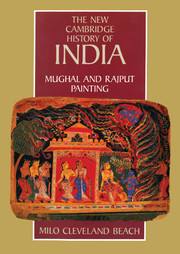Book contents
- Frontmatter
- Introduction
- 1 Painting in North India before 1540
- 2 1540–1580: Painting at Muslim courts
- 3 1580–1600: The new imperial style and its impact
- 4 1600–1660: Mughal painting and the rise of local workshops
- 5 1660–1700: The growth of local styles
- 6 1700–1800: The Dominance of Rajput Painting
- 7 1800–1858: Traditionalism and new influences
- Appendix
- Bibliographical essay
- Index
- The New Cambridge History of India
- References
2 - 1540–1580: Painting at Muslim courts
Published online by Cambridge University Press: 28 March 2008
- Frontmatter
- Introduction
- 1 Painting in North India before 1540
- 2 1540–1580: Painting at Muslim courts
- 3 1580–1600: The new imperial style and its impact
- 4 1600–1660: Mughal painting and the rise of local workshops
- 5 1660–1700: The growth of local styles
- 6 1700–1800: The Dominance of Rajput Painting
- 7 1800–1858: Traditionalism and new influences
- Appendix
- Bibliographical essay
- Index
- The New Cambridge History of India
- References
Summary
The king undressed, and ordered his clothes to be washed, and in the meanwhile he wore his dressing gown; while thus sitting, a beautiful bird flew into the tent, the doors of which were immediately closed, and the bird caught; his Majesty then took a pair of scissors and cut some of the feathers off the animal; he then sent for a painter, and had a picture taken of the bird, and afterwards ordered it to be released.
Jauhar, a private servant of the Mughal Emperor Humayun (r. 1530–1540; 1555–1556) made these observations while describing a moment during Humayun’s flight from the Indian subcontinent. In 1540, a brilliant and able Afghan, Sher Shah, seized control of the kingdom in India established by Humayun’s father Babur in 1526, and Humayun was ousted from power. That a painter was among the few people who accompanied him into exile certainly indicates the importance of painting at his court; while information that the artist was asked to observe and record aspects of the natural world allies Mughal painting to the innovative, if more fanciful, documentary interests of such works as the Ni’matnama. However, painting as precise record of specific events, personalities, or objects is not known among the pre-Mughal Indian traditions we have discussed.
Humayun’s retreat from India was slow. In 1542, he was in the deserts of Sind (now within Pakistan) where his fifteen-year-old empress Hamida Banu Begam gave birth to a son. This child, the future Emperor Akbar, was then left with guardians and attendants while Humayun continued to the court of the Safavid Shah Tahmasp of Iran to ask help in regaining his territories. Successful, and wildly impressed by the splendor of the court he had visited, Humayun returned east with military reinforcements. He captured Kabul (presently the capital of Afghanistan) after a series of battles with his brother Kamran, who had taken advantage of Humayun’s misfortunes to proclaim his own independence and power. Humayun then used Kabul as a base for his campaign to return to India.
- Type
- Chapter
- Information
- Mughal and Rajput Painting , pp. 15 - 38Publisher: Cambridge University PressPrint publication year: 1992



